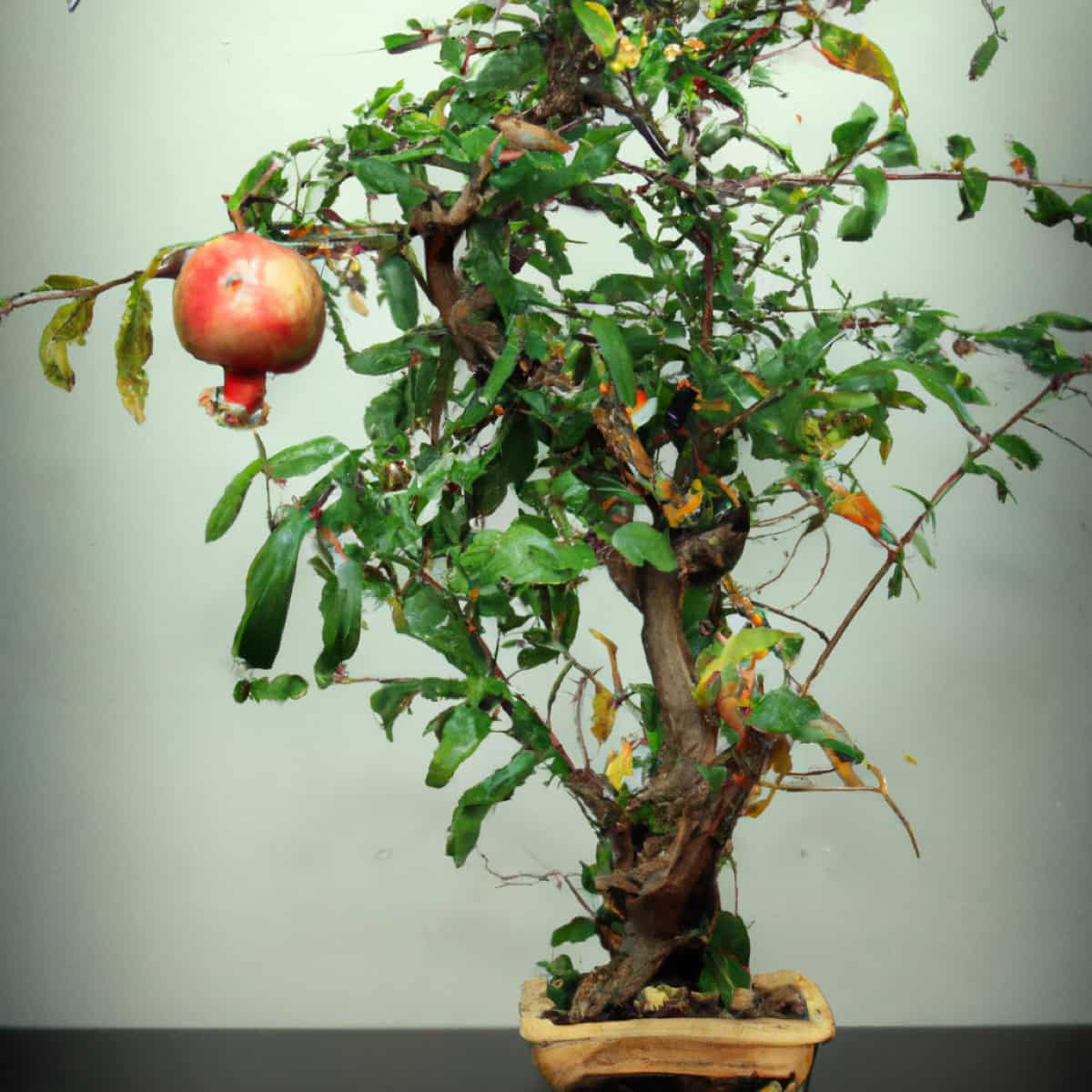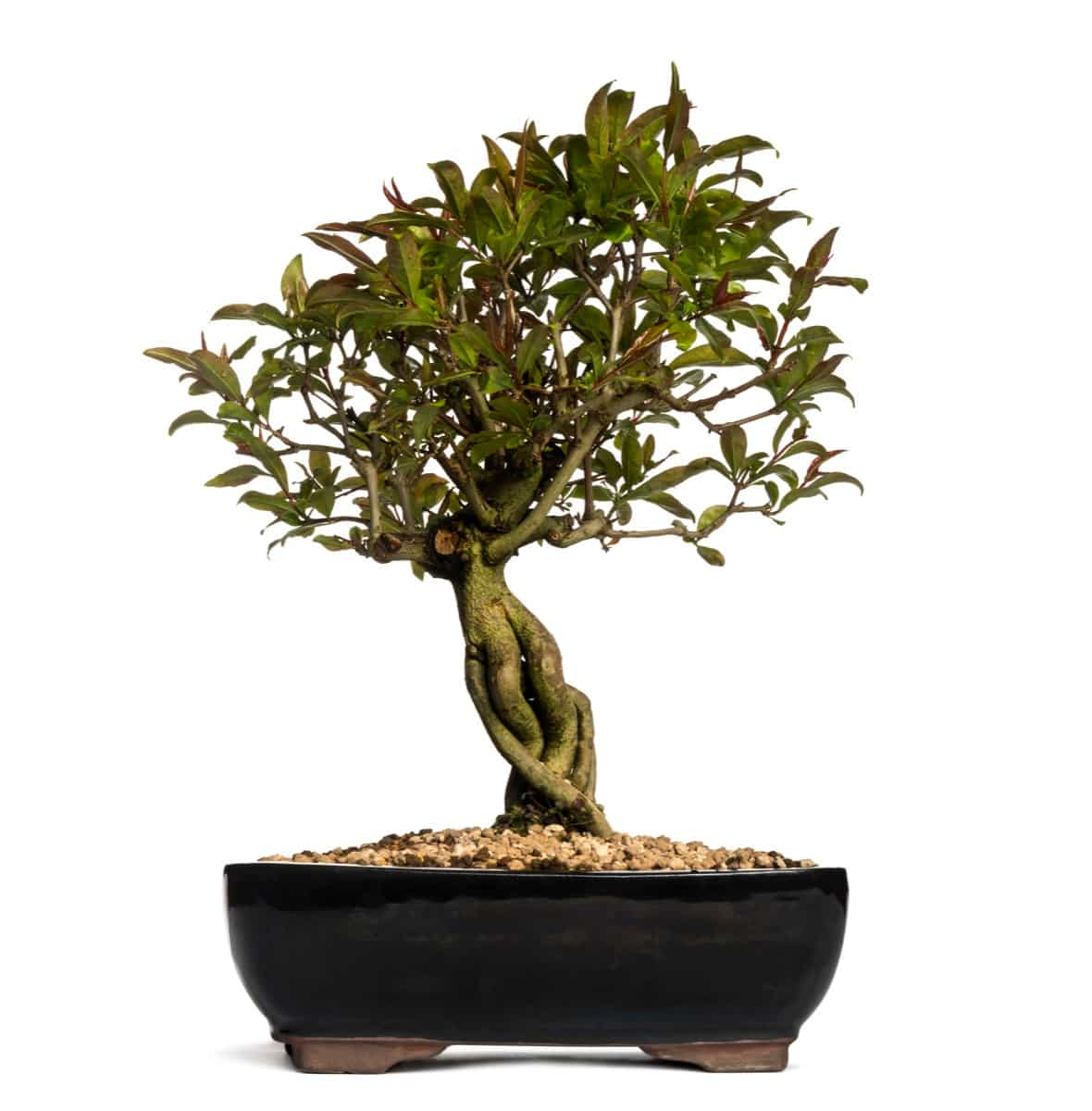Bonsai Pomegranate is a fascinating specimen of the miniature tree world. With its vibrant, ruby-red fruits and intricately twisted trunk, this plant is as captivating as it is rewarding to cultivate. Whether you’re planning to grow a pomegranate bonsai from seed or simply looking for pomegranate bonsai tree care tips, this article will guide you through each step clearly and comprehensively.

How to Pant, Grow and Care for Bonsai Pomegranate
Bonsai Pomegranate Soil Requirements
Creating the optimal environment for your bonsai tree begins with the right soil. Bonsai pomegranate soil requirements are specific, and fulfilling these needs is essential to the plant’s overall health. Pomegranate bonsai trees thrive in a well-draining soil mix, as waterlogged roots can lead to the development of fungal diseases. It’s best to use a mix of organic and inorganic materials. An optimal blend might consist of two parts organic compost to one part coarse sand or gravel. The organic matter provides necessary nutrients, while the inorganic component facilitates drainage and air circulation.
Sunlight Needs for Bonsai Pomegranate
Pomegranate Bonsai trees are lovers of bright, sunny conditions. As such, ensuring your bonsai receives enough light throughout the day is critical. Ideally, your bonsai should receive at least five to six hours of direct sunlight daily. If you’re considering whether are pomegranate bonsai trees indoor or outdoor plants, the answer is both. Pomegranate bonsai trees can be grown indoors but must still be placed near a sunny window or supplemented with artificial light.
Watering Schedule for Bonsai Pomegranate
When it comes to watering your bonsai pomegranate, balance is key. Maintain moisture, but don’t overwater to prevent root rot. Watering should be done when the topsoil feels dry to the touch. Always use a watering can with a fine spray to gently moisten the soil, ensuring the water reaches the roots without disturbing the soil.
How to Grow Bonsai Pomegranate from Seeds
Growing a pomegranate bonsai from seed can be an incredibly rewarding experience. Begin by soaking the seeds in water for 24 hours to facilitate germination. Next, plant the seeds in a potting mix designed for seedlings, ensuring the soil covers them. Put the pot in a sunny spot, keep it warm, and water the soil. Once the seedlings have developed two sets of leaves, they can be carefully transplanted into their bonsai pots.
Planting Instructions for Bonsai Pomegranate
When you’re ready to plant your pomegranate bonsai, begin by choosing an appropriate container. The pot should have sufficient drainage holes and be large enough to accommodate the plant’s roots. Place a layer of well-draining soil at the bottom of the pot, followed by the plant. Fill the remaining space with soil, gently patting it down to remove any air pockets. Water thoroughly after planting to help the soil settle.
Training Methods for Bonsai Pomegranate
Training your bonsai is a crucial aspect of its care. This is where you can begin to create a twisted pomegranate bonsai if you wish. It’s best to start training your bonsai when it’s still young, and its branches are flexible. The two most common training methods are wiring and pruning. Wiring involves wrapping wire around the branches and gently bending them into your desired shape. The wires should be removed once the branches have held the shape, which can take several months.
In case you missed it: How to Pant, Grow, and Care for Bonsai Citrus

Fertilizing Techniques for Bonsai Pomegranate
Proper fertilization is crucial for the optimal growth and vitality of your bonsai pomegranate. It is recommended to use a well-balanced fertilizer with an NPK ratio of 10-10-10. During the active growth period, fertilize the plant every two weeks. However, during winter, reduce the frequency to once a month. Remember to apply the fertilizer to damp soil to avoid damaging the roots.
Repotting Bonsai Pomegranate
Repotting your bonsai pomegranate is necessary to provide fresh soil and more room to grow. This should be done every two to three years for younger trees and every three to five years for older ones. The best time to repot is in early spring, just before the start of the growing season. Carefully remove the tree from its pot, trim it to one-third of the root ball, and place it in its new pot with fresh soil.
Pruning Techniques for Bonsai Pomegranate
Pruning is another essential step in caring for your bonsai. This not only helps to maintain the shape of the tree but also encourages new growth. Prune your pomegranate bonsai in early spring, first removing any dead or unhealthy branches. Then, trim back the remaining branches to maintain the tree’s form. Always make your cuts at an angle to encourage healthier growth.
Pest and Disease Control for Bonsai Pomegranate
Keeping your pomegranate bonsai healthy involves vigilant pest and disease control. Regularly inspect your bonsai for signs of common pests like aphids, spider mites, or scale insects. Treat the plant with a mild insecticide or soapy water solution if you notice any. Diseases can often be prevented by ensuring your bonsai has the right growing conditions and proper care. However, if you notice discolored leaves or slow growth, it may indicate a fungal or bacterial disease requiring appropriate treatment.
Winter Care for Bonsai Pomegranate
Winter care is crucial for the survival of your bonsai. Pomegranate bonsai trees are not frost-tolerant and need protection during cold weather. If you’re wondering what temperature is good for pomegranate bonsai, they prefer a range between 40°F to 100°F. Anything below this can be harmful. During winter, move your bonsai indoors or into a greenhouse. Ensure it gets ample light, and reduce watering as the plant’s growth slows.
Displaying Your Bonsai Pomegranate
Choosing the right location to display your bonsai pomegranate can significantly enhance its beauty. The location should have adequate light, suitable temperature, and good air circulation. It’s crucial to remember that while bonsai are compact, they still require room to breathe. Your bonsai pomegranate is a living work of art and should be displayed accordingly.
Consider a sturdy table or bench for its display, but avoid high-traffic areas where it may be knocked over or disturbed. Similarly, while bonsai are frequently displayed in groups, each tree should still have its space. Ultimately, your chosen location should enhance your bonsai’s aesthetics while catering to its physiological needs.
In case you missed it: 9 Causes of Dying Pomelo Tree and How to Fix It?

Conclusion
Growing and caring for a pomegranate bonsai can be a labor of love, but the reward is well worth the effort. With patience, dedication, and the right care, you can cultivate a healthy and beautiful bonsai that will be a prized possession for many years to come.
- Feed Your Flock for Less: Top 10 Tips to Save on Chicken Feed
- Ultimate Guide to Ossabaw Island Hog: Breeding, Raising, Diet, and Care
- Hatching Answers: The Top 10 Reasons Your Chickens Aren’t Laying Eggs
- Eggs and Economics: Breaking Down the Cost of Raising Backyard Chickens
- Defend Your Greens: Proven Methods to Keep Iguanas Out of Your Garden
- Ultimate Guide to Cinnamon Queen Chicken: A Comprehensive Guide for Beginners
- Ultimate Guide to California Tan Chicken: Breeding, Raising, Diet, Egg-Production and Care
- Ultimate Guide to Marsh Daisy Chicken: Breeding, Raising, Diet, and Care
- 10 Types of Chicken Farming Businesses You Can Start for Profits